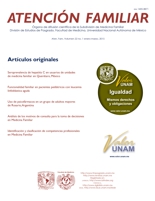Identification and Classification of Professional Competencies in Family Medicine
Main Article Content
Abstract
Objective: identify the professional competencies of the Family Medicine specialist in Mexico. Methods: qualitative, and descriptive study, and occupational analysis; with prior informed consent. It was applied the Developing a Curriculum (Dacum), Team Kawakita Jiro (tkj) and Critical Incident (ci) techniques in a sample of 152 specialists in Family Medicine. Using the technique of analysis of content some concepts and ideas were identified and organized by categories and domains of competence. The results were compared with similar studies in the United States, United Kingdom, Spain, and Canada. Results: from the 1 840 records collected from the three techniques, it was obtained 3 831 concepts; from these and using the Dacum technique, it was identified 57 different categories in relation to knowledge, skills and attitudes; the tkj technique recognized 879 concepts of essential elements to provide family medical care; and the ci technique identified 21 categories of essential elements for solving problems in the practice of Family Medicine. All identified categories were merged by similarity of content according to the three techniques and 42 different categories were concluded, which were considered as competences. Finally, they were grouped into 12 competence domains. Conclusions: the framework of competences of this study will allow bringing into the program of the “Family Medicine Course of Specialization” certified by the National Autonomous University of Mexico (unam), the necessary elements to train specialists in this discipline towards the achievement of their professional skills.
Downloads
Download data is not yet available.
Article Details
How to Cite
Gómez-Clavelina, F., Hernández-Torres, I., & Grijalva, M. G. (2015). Identification and Classification of Professional Competencies in Family Medicine. Atención Familiar, 22(1). https://doi.org/10.22201/facmed.14058871p.2015.1.47980
